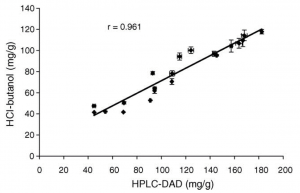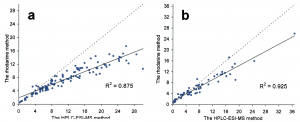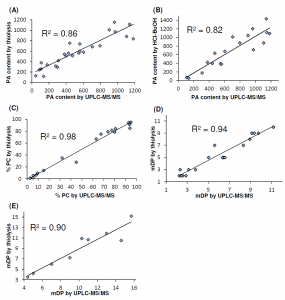There are multiple options available for the chemical analyses of plants, but do you really know which of the options gives meaningful and natural-like qualitative and quantitative results for the plant defense compounds?
Plants are full of specialized challenges for their chemical analysis

Figure 1. Concentrations of proanthocyanidins (in mg/g dry weight) measured from twenty dog rose hip extracts with the conventional HCl–butanol assay and the HPLC–DAD method developed by Salminen et al. 2005. All extracts were measured in triplicate. Values show mean±SE. It can be seen that at low concentrations the methods tend to agree better, but at high concentrations results differ even by more than 50%. Which one of the methods produces more natural results? See Salminen et al. 2005 for the answer.
This is our bread and butter. This is in our DNA at the Natural Chemistry Research Group. We focus on the detailed analysis of metabolites produced by the plant cell. More specifically, we focus on secondary metabolites that can be called also specialized metabolites or natural compounds. We feel that sometimes they could be even called specialized challenges, due to their complicated and deliquate chemical structures. Of these challenges, our analysis platform has included phenolic compounds, terpenoids, alkaloids, cyanogenic glycosides and glucosinolates. Our main targets naturally are polyphenols and more specifically their most complex forms, i.e. different types of tannins. All of these different types of compounds require a bit differently optimized analysis methods and of course also sample preparation protocols.
Can you ever claim to be able to truly quantify natural compounds?

Figure 2. Contents of total galloylglucoses from 117 mountain birch samples (a), and 60 dwarf birch samples (b), measured both with the conventional rhodanine (gallic acid equivalents mg/g dry wt) and the HPLC–ESI-MS (sum of individual galloylglucoses mg/g dry wt) method developed by Salminen et al. (2001). The solid line shows linear regression between the results; dashed line represents the situation where both methods would give equal results. Which of the two methods give more natural results for the galloylglucoses? See Salminen (2003) for the answer.
We aim to develop all steps of our analysis protocols to such extents that it would be possible to try to estimate the true quantity of plant metabolites present in a plant sample. We need to stress out that even if our tools were be the best ones available, we still cannot claim to be able to quantify the true content of all plant metabolites. There are so many variables starting from plant sampling that can alter both the structures and concentrations of the metabolites that extreme care should be taken when true quantitative protocols are to be achieved (see Figs 1-3 for examples). Please have a closer look at our Quantitative Analysis of Plants for more information on this aspect.
Quantitative protocols need to be followed by quantitative results

Figure 3. The results obtained by the rapid tannin fingerprinting tool developed by Engström et al. (2014) was compared against the conventional HCl-BuOH and thiolysis assays in its ability to measure the proanthocyanidin concentration (A-B), the procyanidin (PC) percentage among the proanthocyanidins (C) and the mean degree of polymerization (mDP) for the proanthocyanidins (D-E) present in plants. Do you know which of these methods is the most convenient to use and produces the most informative results? See Engström et al. (2014) for the answer.
Once the quantitative protocols are developed, plant samples need to be systematically and carefully treated according to the protocol. After the final quantitative step the raw results need to be evaluated for their accuracy. Finally, the results are to be expressed in quantitative mg/g DW equivalents by using the best possible standard available to each compound to be quantified.
Many of the above aspects are dealt in detail in the section Quantitative Analysis of Plants. Here we continue with the Development of Chromatographic Methods, Analysis of Individual Tannins, Analysis of Functional Groups of Tannins, Analysis of Functional Properties of Tannins, and Analysis of Terpenes & Alkaloids.
“Everyone can analyse plants for chemistry – and all results can be different.”
